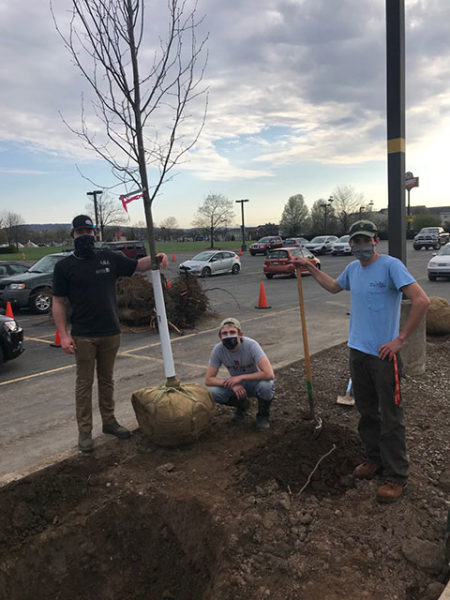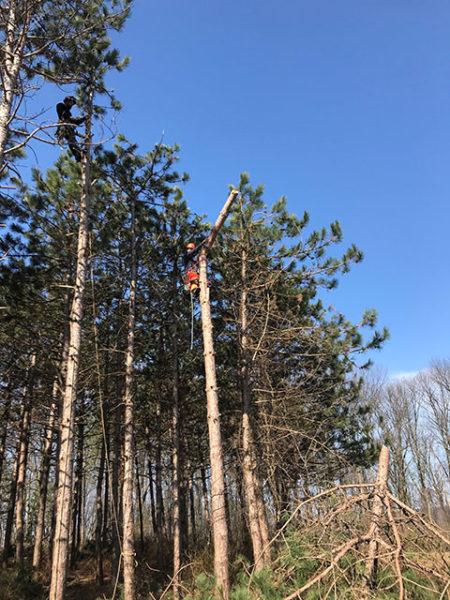Students encounter ups AND downs ... and it's all good!
Published 04.22.2021
News
Forestry
Landscape/Plant Production
Alumni News
Student News
Faculty & Staff
Engineering Technologies
Whether working below ground level or well into the treetops, Michael A. Dincher's students get to experience the wide scope of arboriculture.
 An assistant professor of horticulture, Dincher recently brought his Schneebeli Earth Science Center class to main campus to assist General Services in replacing diseased trees near the Campus View Apartments. The GS grounds department had cited the trees as a safety concern, as many of them had dead and dying branches due to extremely poor soil conditions.
An assistant professor of horticulture, Dincher recently brought his Schneebeli Earth Science Center class to main campus to assist General Services in replacing diseased trees near the Campus View Apartments. The GS grounds department had cited the trees as a safety concern, as many of them had dead and dying branches due to extremely poor soil conditions.
"When the parking lot was created, the contractor planted the trees in cracker dust (limestone screenings); no soil," explained Andrea L. Dildine, horticulturist/grounds and motorpool manager. "Every fall, we evaluate tree conditions on campus. We always like to add trees to better the environment and participate with Tree Campus USA. When planting trees, we like to diversify our species, allowing better chances for survival from disease and insect damage. If you plant the same species, a disease or insect infestation can affect a large amount of trees in a single area on campus."
 It was decided to replace the dead zelkova trees with “Happidaze” sweetgum, “Exclamation” London planetree and “Burgundy Belle” maples, she said, adding that her department reached out to Dincher.
It was decided to replace the dead zelkova trees with “Happidaze” sweetgum, “Exclamation” London planetree and “Burgundy Belle” maples, she said, adding that her department reached out to Dincher.
"Mike likes his students to learn about planting bare-root trees and balled-and-burlapped trees," Dildine said. "He and his students were interested in planting the trees in the CVA parking lot knowing that they were 'B&B' trees."
General Services removes each dead tree and root system, and the class plants the new ones.
Ten miles south, in the living laboratory surrounding the ESC, Dincher's students took to the skies to remove two trees infected by diplodia tip blight.
"We used tree-climbing spikes to ascend into the canopy and remove all the branches on the way up to the top, then cut to remove the top of the tree and left the rest standing," said Wyatt C. Forest – a forest technology student, landscape/horticulture technology alumnus and laboratory assistant for horticulture. The trees will season in place for a year, then be felled and prepped for a lean-to shelter to be built by assistant professor Andrew Bartholomay's Forest Recreation class.
 An assistant professor of horticulture, Dincher recently brought his Schneebeli Earth Science Center class to main campus to assist General Services in replacing diseased trees near the Campus View Apartments. The GS grounds department had cited the trees as a safety concern, as many of them had dead and dying branches due to extremely poor soil conditions.
An assistant professor of horticulture, Dincher recently brought his Schneebeli Earth Science Center class to main campus to assist General Services in replacing diseased trees near the Campus View Apartments. The GS grounds department had cited the trees as a safety concern, as many of them had dead and dying branches due to extremely poor soil conditions."When the parking lot was created, the contractor planted the trees in cracker dust (limestone screenings); no soil," explained Andrea L. Dildine, horticulturist/grounds and motorpool manager. "Every fall, we evaluate tree conditions on campus. We always like to add trees to better the environment and participate with Tree Campus USA. When planting trees, we like to diversify our species, allowing better chances for survival from disease and insect damage. If you plant the same species, a disease or insect infestation can affect a large amount of trees in a single area on campus."
 It was decided to replace the dead zelkova trees with “Happidaze” sweetgum, “Exclamation” London planetree and “Burgundy Belle” maples, she said, adding that her department reached out to Dincher.
It was decided to replace the dead zelkova trees with “Happidaze” sweetgum, “Exclamation” London planetree and “Burgundy Belle” maples, she said, adding that her department reached out to Dincher."Mike likes his students to learn about planting bare-root trees and balled-and-burlapped trees," Dildine said. "He and his students were interested in planting the trees in the CVA parking lot knowing that they were 'B&B' trees."
General Services removes each dead tree and root system, and the class plants the new ones.
Ten miles south, in the living laboratory surrounding the ESC, Dincher's students took to the skies to remove two trees infected by diplodia tip blight.
"We used tree-climbing spikes to ascend into the canopy and remove all the branches on the way up to the top, then cut to remove the top of the tree and left the rest standing," said Wyatt C. Forest – a forest technology student, landscape/horticulture technology alumnus and laboratory assistant for horticulture. The trees will season in place for a year, then be felled and prepped for a lean-to shelter to be built by assistant professor Andrew Bartholomay's Forest Recreation class.
Photos provided by Michael A. Dincher